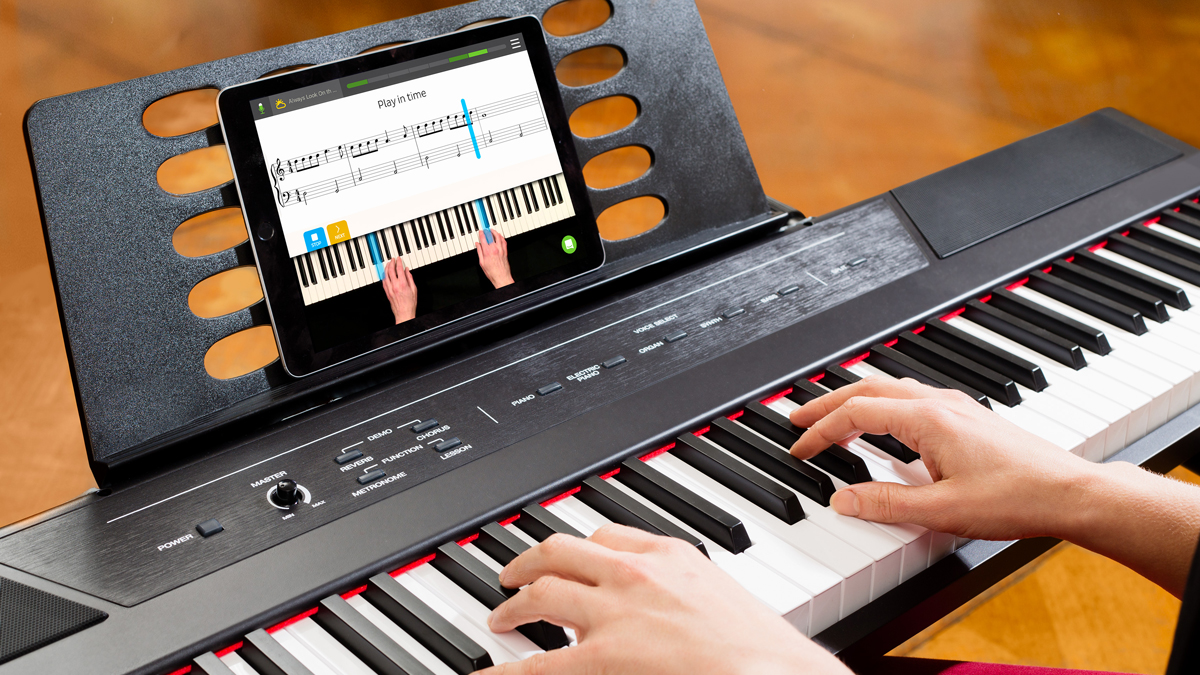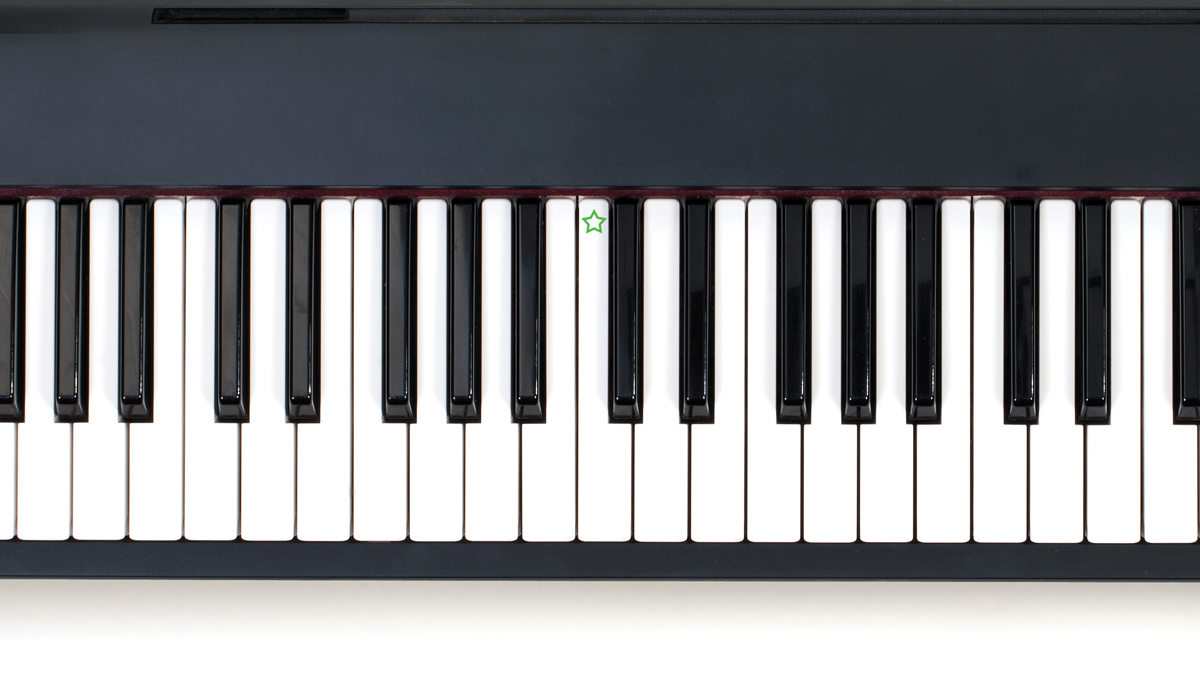Piano basics: the black notes - what are they for and how do you use them?
Fear of a black key?… Don't be afraid. Adding flats and sharps to your music will give it a new lease of life.

The layout of a piano keyboard is perhaps the most recognisable pattern in music – a black and white staggered staircase that sits on the front of every piano, organ and synthesizer and – back in the '80s – more than a few thin leather ties…
But what's with the white and black? And why are the black keys in groups of threes and twos? And why have white and black keys at all?
And why – when they sound weird – should I bother with the black notes any way?

• Explore our pick of the best digital pianos
• The best online piano lessons available today
• Learn the white keys on piano
Allow us to explain why a keyboard is laid out as it is and why those 'weird' black notes are actually the most interesting notes on the keyboard.
It's tempting when first learning and playing keyboards to give the black keys the swerve…
They always sound 'weird' and bashing out triad chords with the white keys (spacing them out by a note or two) always seems to just work.
So what are black keys for anyway? Allow us to explain.
Want all the hottest music and gear news, reviews, deals, features and more, direct to your inbox? Sign up here.
You need to get used to the idea of tones and semitones. The white keys are tones and the black keys are semitones. That is, the white keys are a full tone apart, and the black keys are the half-tones in between them.
Take a moment to play consecutive keys moving up the keyboard. Start at C (there's a handy tip for finding C easily below – see 'So which note is which'…) and play up, using just the white keys until you reach the next C.
You've just played the C major scale. Notice how everything sounded 'correct' and logical?
Tones and semitones
Tones and semitones (or steps and half steps) are common terms to define distance between notes. A semitone is the distance between each key on the keyboard. Each sharp or flat will be a semitone away from its corresponding white key. The distance between E & F and B & C is also a semitone as there are no black keys between them.
That's because there's a perfect mathematical symmetry at play here, with the number of Hz each note vibrates at increasing in a logical sequence, and doubling from one C up to the next… And the human brain loves a bit of symmetry (even if it doesn't realise that it's being fed it).
So, after thousands of years, your brain is actually unwittingly programmed to 'like' and approve of this sequence of increasing tones and the gaps between them.
Now do the same again, playing every consecutive key INCLUDING the black notes.
Notice again how everything sounded great? The semi-tones – through a thousand years of consensus on their tuning and 'where they should be' – effectively 'fill in the gaps' between the white tones and give a logical 'other place' for musicians to go.
And the interplay of white and black notes? Basically, that's the musical difference between your melody and chord sequences sounding boring and predictable and being interesting and surprising.
Two black keys… Three black keys…?
By now, it won't have escaped you that the actual pattern of the black keys is 'uneven'. i.e. There are two black keys, then three… And in blocks… Repeating up the keyboard. Why is this?
Simply put, thanks to that agreement on 'what keys should be tuned to what pitch' – resulting in the equal temperament tuning that we use on western instruments – the notes E and F and B and C are actually a semitone apart. So there's no need for a black 'in between' note between those notes.
Hence the gap in the blocks of black notes.
And – handily – that gap gives us an instantly recognisable 'landmark' for finding our way along the keyboard. The two-then-three pattern marks out a single octave – the point at which the sequence of notes musical begins again.
(One for the maths fans: Each octave is double the Hz of the one previously, right up the piano keyboard.)
Try playing the same note in different octaves. Hear how they sound 'the same'? (Interject a few off notes in your playing if you don't believe us… Get it?)
You're not able to literally count the number of Hz of each note, but your brain – somehow – can sense it…
So which note is which?

OK. Let's learn which note is called what.
Find the two black notes that sit together. You'll find them at multiple positions across the piano keyboard.
The white key to their left is always a C… It's marked with a star in the picture above.
Flats
Black keys to the left of white keys are flats. From C (starred above) down an octave these are Bb, Ab, Gb, Eb and Db.
Sharps
Any black key to the right of a white key is a sharp. From Middle C up an octave these are C#, D#, F#, G# and A#.
White keys
If you need help, remember the three white keys around the two black keys are C, D and E, while the other four are F, G, A and B.
Then, moving up the keyboard, looking at just the white notes, you'll consecutively find D, E, F, G, A, B and C again, left to right, all the way up the keyboard.
Every C is the white key to the left of the two black notes. Every time. See?
And – as we said earlier – the black key are the 'halfway' steps between them.
They're know as sharp and flats. A sharp is a note that’s half a step higher, falling to the right of the white key you're playing. And the flats are the black keys that are half a step lower, being to the left the white key you're playing.
So the five black keys are – moving up through an octave – C-sharp, D-sharp, F-sharp, G-sharp and A-sharp (usually written as C#, D#, F#, G# and A#).
Alternatively they can also be named D-flat, E-flat, G-flat, A-flat and B-flat (usually written as Db, Eb, Gb, Ab and Bb).
Remember: The tones E and F, and B and C are a semitone apart already. So there is no such thing as E#, Fb, B# or Cb piano key.
Take some time learning what the names of the black keys are and see if you can recognise the difference in pitch with their corresponding white key.
With all the keys named, let's start playing them.
Get the right technique

Step 1: The first thing to get right is your technique. You don’t really want to get into the habit of using your thumb on the black keys. As your playing skill progresses and speeds up this will only slow you down.
Instead, try to only use your middle three fingers. This makes it easier to transition between white and black. There will be times when this is unavoidable, but until this is the case, try to keep your thumb away.

Step 2: When playing the black keys you might need to tuck your thumb under your fingers to hit a white key. Try this now - play Middle C with your right index finger, C# with your middle finger and then D with your thumb. Later on, you will find this technique useful when performing scales.

Step 3: Let’s try the same technique with the left hand. Place your left thumb on Middle C. Now play B with your index finger, Bb with your middle finger and then A with your thumb. Practise until it feels natural. Now your thumb is on A, it frees up the rest of your fingers to play lower notes, both black and white.

Step 4: Let’s attempt a scale. Starting with your index finger on your right hand and, working from C to F, see if you can play the white and black keys in a fluid motion. Use your thumb for D, and end with your fourth finger on F. Once you’ve mastered that, go back down again using the same fingers.
Have fun – and don't fear the black keys
Try hammering out a few triad chords – three notes spaced out, played together.
Try only white notes first. Moving a triad hand 'shape' in steps up and down the keyboard…
Now, try introducing a black note with one of those three fingers and experiment.
You should quickly find some interesting chord changes that are above and beyond your usual playing.
Go crazy, add a second black note… Or a third…
But above all, don't be afraid to experiment and make your music your own. If it sounds good – use it.
Have fun!
MusicRadar is the number one website for music-makers of all kinds, be they guitarists, drummers, keyboard players, DJs or producers...
- GEAR: We help musicians find the best gear with top-ranking gear round-ups and high-quality, authoritative reviews by a wide team of highly experienced experts.
- TIPS: We also provide tuition, from bite-sized tips to advanced work-outs and guidance from recognised musicians and stars.
- STARS: We talk to musicians and stars about their creative processes, and the nuts and bolts of their gear and technique. We give fans an insight into the craft of music-making that no other music website can.
You must confirm your public display name before commenting
Please logout and then login again, you will then be prompted to enter your display name.
